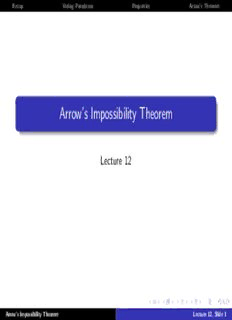
Arrow's Impossibility Theorem PDF
Preview Arrow's Impossibility Theorem
Recap VotingParadoxes Properties Arrow’sTheorem Arrow’s Impossibility Theorem Lecture 12 Arrow’sImpossibilityTheorem Lecture12,Slide1 Recap VotingParadoxes Properties Arrow’sTheorem Lecture Overview 1 Recap 2 Voting Paradoxes 3 Properties 4 Arrow’s Theorem Arrow’sImpossibilityTheorem Lecture12,Slide2 Recap VotingParadoxes Properties Arrow’sTheorem Social Choice Definition (Social choice function) Assume a set of agents N = {1,2,...,n}, and a set of outcomes (or alternatives, or candidates) O. Let L be the set of non-strict - total orders on O. A social choice function (over N and O) is a function C : L n (cid:55)→ O. - Definition (Social welfare function) Let N,O,L be as above. A social welfare function (over N and - O) is a function W : L n (cid:55)→ L . - - Arrow’sImpossibilityTheorem Lecture12,Slide3 Recap VotingParadoxes Properties Arrow’sTheorem Some Voting Schemes Plurality pick the outcome which is preferred by the most people Plurality with elimination (“instant runoff”) everyone selects their favorite outcome the outcome with the fewest votes is eliminated repeat until one outcome remains Borda assign each outcome a number. The most preferred outcome gets a score of n−1, the next most preferred gets n−2, down to the nth outcome which gets 0. Then sum the numbers for each outcome, and choose the one that has the highest score Pairwise elimination in advance, decide a schedule for the order in which pairs will be compared. given two outcomes, have everyone determine the one that they prefer Arrow’sImpossibilityTheeloimreminate the outcome that was not preferred, and contLinecutuere12,Slide4 with the schedule Recap VotingParadoxes Properties Arrow’sTheorem Condorcet Condition If there is a candidate who is preferred to every other candidate in pairwise runoffs, that candidate should be the winner While the Condorcet condition is considered an important property for a voting system to satisfy, there is not always a Condorcet winner sometimes, there’s a cycle where A defeats B, B defeats C, and C defeats A in their pairwise runoffs Arrow’sImpossibilityTheorem Lecture12,Slide5 Recap VotingParadoxes Properties Arrow’sTheorem Lecture Overview 1 Recap 2 Voting Paradoxes 3 Properties 4 Arrow’s Theorem Arrow’sImpossibilityTheorem Lecture12,Slide6 B What would win under plurality voting? A What would win under plurality with elimination? C Recap VotingParadoxes Properties Arrow’sTheorem Condorcet example 499 agents: A (cid:31) B (cid:31) C 3 agents: B (cid:31) C (cid:31) A 498 agents: C (cid:31) B (cid:31) A What is the Condorcet winner? Arrow’sImpossibilityTheorem Lecture12,Slide7 What would win under plurality voting? A What would win under plurality with elimination? C Recap VotingParadoxes Properties Arrow’sTheorem Condorcet example 499 agents: A (cid:31) B (cid:31) C 3 agents: B (cid:31) C (cid:31) A 498 agents: C (cid:31) B (cid:31) A What is the Condorcet winner? B Arrow’sImpossibilityTheorem Lecture12,Slide7 A What would win under plurality with elimination? C Recap VotingParadoxes Properties Arrow’sTheorem Condorcet example 499 agents: A (cid:31) B (cid:31) C 3 agents: B (cid:31) C (cid:31) A 498 agents: C (cid:31) B (cid:31) A What is the Condorcet winner? B What would win under plurality voting? Arrow’sImpossibilityTheorem Lecture12,Slide7 What would win under plurality with elimination? C Recap VotingParadoxes Properties Arrow’sTheorem Condorcet example 499 agents: A (cid:31) B (cid:31) C 3 agents: B (cid:31) C (cid:31) A 498 agents: C (cid:31) B (cid:31) A What is the Condorcet winner? B What would win under plurality voting? A Arrow’sImpossibilityTheorem Lecture12,Slide7
Description: